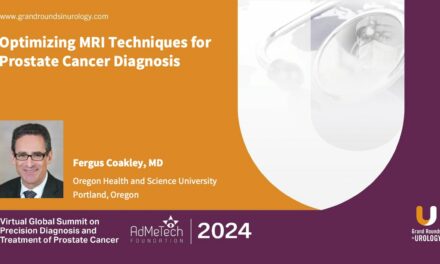Phillip J. Koo, MD, presented “Practical Applications and Clinical Utility of PYLARIFY Injection: Implications for Urology and Radiation Oncology” during the virtual 5th Global Summit on Precision Diagnosis and Treatment of Prostate Cancer in September 2021.
How to cite: Koo, Phillip J. “Practical Applications and Clinical Utility of PYLARIFY Injection: Implications for Urology and Radiation Oncology.” September 2021. Accessed Aug 2025. https://grandroundsinurology.com/practical-applications-and-clinical-utility-of-pylarify-injection-implications-for-urology-and-radiation-oncology/
Practical Applications and Clinical Utility of PYLARIFY Injection: Implications for Urology and Radiation Oncology – Summary
In this presentation, supported by Lantheus, Phillip J. Koo, MD, Division Chief of Diagnostic Imaging and Northwest Region Oncology Physician Executive at the Banner MD Anderson Cancer Center in Phoenix, Arizona, discusses the expansion of the role and utility of prostate-specific membrane antigen (PSMA) positron emission tomography/computed tomography (PET/CT) in the management of prostate cancer. He discusses PYLARIFY (piflufolastat F 18) Injection and shares important safety information, including that related to the risk of image misinterpretation, hypersensitivity reactions, radiation risks, adverse reactions, and drug interactions. He explains that it is a radioactive diagnostic agent indicated for PET and PSMA positive lesions in men with prostate cancer with suspected metastasis who are candidates for initial definition therapy or with suspected recurrence based on elevated serum prostate-specific antigen (PSA) level. Dr. Koo reviews conventional imaging techniques and outlines the pros and cons of each before turning to next-generation imaging (NGI), explaining that it leverages established technology to create higher resolution images than conventional scans. He lists NGI options that the U.S. Food and Drug Administration (FDA) has now approved, such as 18F-FACBC, 68Ga-PSMA-11, and PYLARIFY. He cites a study of 68Ga-PSMA-11 in patients with biochemical recurrence (BCR) post-radical prostatectomy (RP) to illustrate the detection rate (at 0.2 – 0.5 PSA level it was 65 percent) and he points out that understanding of prostate cancer and metastases really only scratches the surface. Dr. Koo then cites a study showing the overall detection rate with PSMA is almost double than with 18F-FACBC. He describes the history of the PYLARIFY clinical program from its beginnings at Johns Hopkins University through the phase 2-3 OSPREY trial and the phase 3 CONDOR trial, which led to the new drug application in 2020 and commercialization in 2021. Dr. Koo then compares PSMA and conventional imaging, highlighting that PSMA offers superior accuracy, greater treatment impact, and fewer uncertain results. Dr. Koo closes with final recommendations, including that practitioners should consider a PSMA PET/CT at initial diagnosis for patients with negative conventional imaging or where there is a high suspicion of metastatic disease; he also opines that any patient with initial biomedical recurrence ought to receive PSMA PET/CT. Finally, Dr. Koo refers to RADAR III for further information and guidance.
The Virtual Global Summit on Precision Diagnosis and Treatment of Prostate Cancer brings together key international opinion leaders of every clinical subspecialty involved in patient care. This event is an integral part of the AdMeTech Foundation’s Annual Summit, which was established in 2016 and became seminal in shaping the state of the art and future vision for precision care. The goal of this event is three-fold: 1) Educating the key stakeholders; 2) Supporting a sustained cross-disciplinary dialogue and consensus on the best emerging clinical practices and research priorities; and 3) Expediting clinical adoption of promising novel diagnostics and therapeutics. For more educational activities from this virtual event, visit our collection page.
ABOUT THE AUTHOR
Phillip J. Koo, MD, is the Chief of Diagnostic Imaging at the Banner MD Anderson Cancer Center in Phoenix, Arizona. Prior to this, he was Chief of Nuclear Medicine and Associate Professor of Radiology at the University of Colorado School of Medicine in Aurora, Colorado. He completed his fellowship at the Harvard Medical School Joint Program in Nuclear Medicine in Boston, Massachusetts. Dr. Koo is a diplomate of both the American Board of Radiology (ABR) and American Board of Nuclear Medicine(ABNM).





